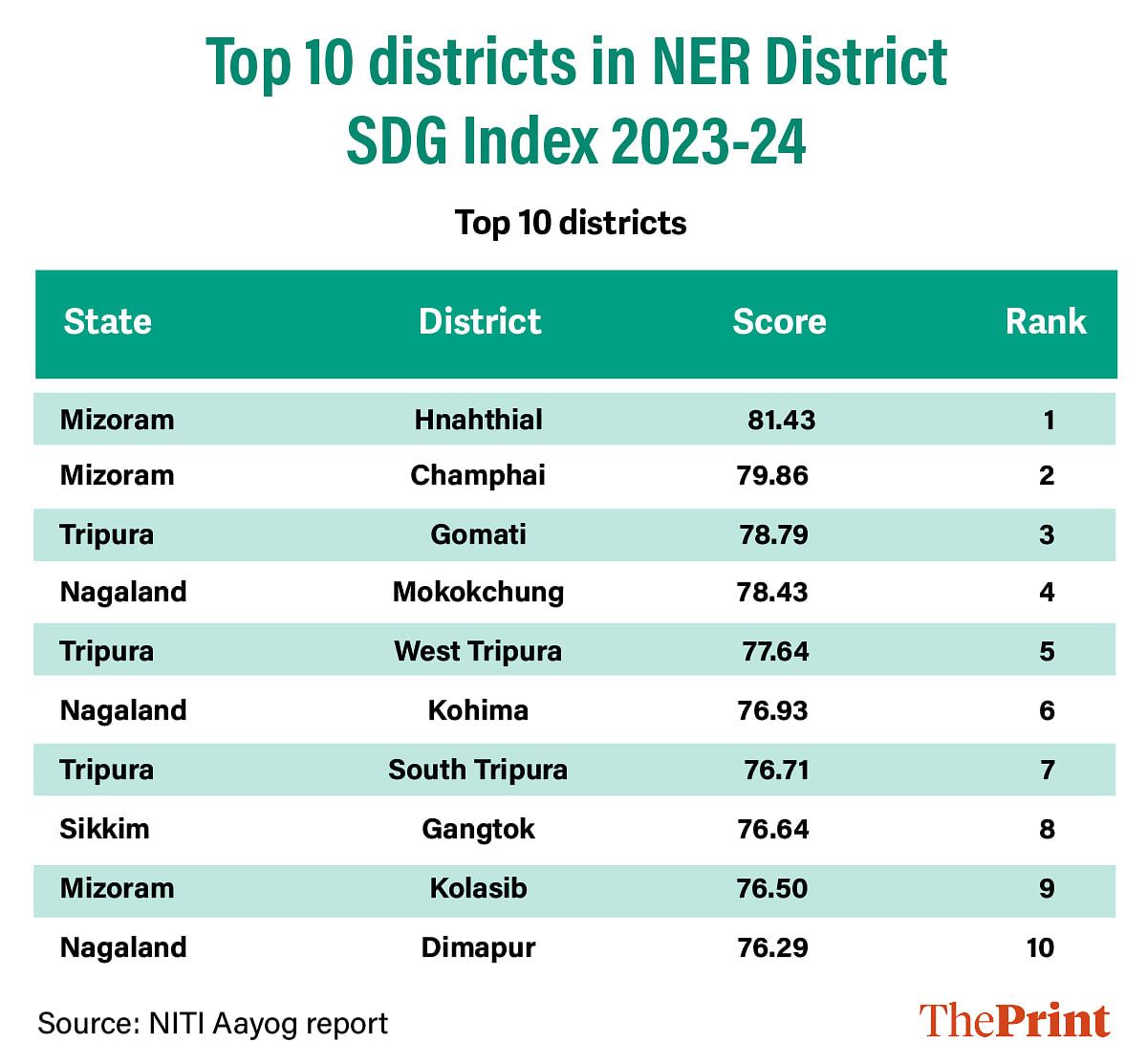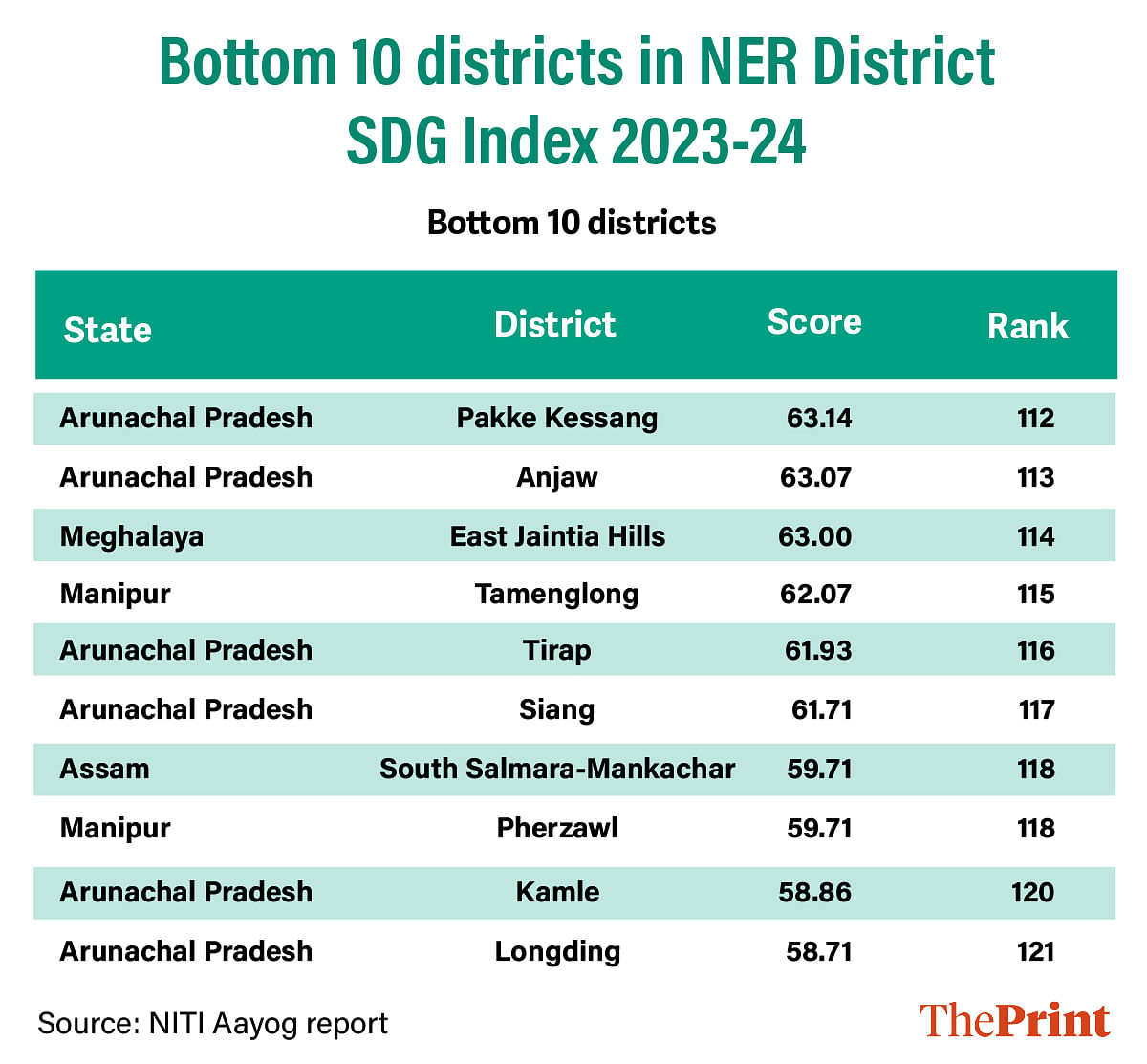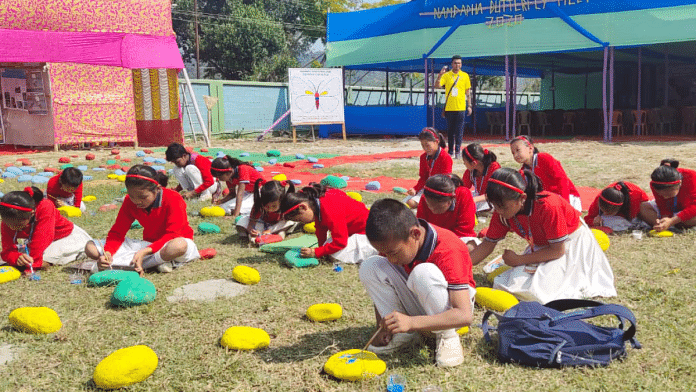New Delhi: Hnahthial and Champhai in Mizoram, Gomati and West Tripura in Tripura, and Mokokchung in Nagaland have been ranked the top five districts of the north-east in the 2023-24 North Eastern Region (NER) District SDG Index report released Monday by the Niti Aayog.
The index, which covered 131 (92 percent) districts of the eight north-eastern states—Assam, Arunachal Pradesh, Manipur, Meghalaya, Mizoram, Nagaland, Tripura and Sikkim—measured their performance across 15 Sustainable Development Goals (SDGs) comprising 84 indicators.These include poverty, hunger, health, quality of education, gender equality, access to clean water and sanitation, clean energy, industry, innovation and infrastructure, economic growth, responsible consumption and production among others.
SDG 14 and 17 were excluded because of their limited or no applicability at the district-level.
The districts have been ranked based on a composite score that ranges from 0 to 100 and denotes the district’s overall achievement in realising the targets under the SDGs. A score of 100 implies that the district has achieved the targets set for identified 82 indicators; a score of 0 implies that the district is at the bottom.
Based on the score, each district is categorised into one of the four categories: Achiever (when the score equals 100), Front Runner (when the score is between 65 and 100 excluding 100), Performer (when the Index score is between 50 and 65, excluding 65) and Aspirant (when the Index score is less than 50).
Overall, 85 percent of the NER districts are in the front runner category compared to the previous edition, where 62 percent of the districts were in this category.
Of the eight north-eastern states, Mizoram, Sikkim and Tripura are right at the top, with all their districts falling in the front runner category. Hnahthial district in Mizoram has got the highest-score of 81.43 while Longding at 58.71 has the lowest score in the entire north-eastern region.
Nagaland exhibits widest range (15.07 points between its highest and lowest performing
districts), indicating the significant intra-state disparity. Sikkim has the narrowest range (5.5 points), showing the most consistent performance, while Tripura has the distinction of having some of the highest-scoring districts with minimum intra-state disparities (6.5 points).
Mizoram and Nagaland have some of the highest-scoring districts, but also show significant intra-state variation (ranges of 13.72 and 15.07, respectively).
Overall, of the 131 districts covered,10 were not considered for computation as data for various indicators was not available.
This is the second edition of the report and has come out after two years. The first edition was released in August 2021 and covered 103 of the 120 districts (86 percent).
How have districts fared in some of the crucial SDGs


Mokokchung in Nagaland, Gangtok in Sikkim, Thoubal in Manipur, West Tripura in Tripura, Saitual in Mizoram, Imphal East in Manipur and South Tripura in Tripura are the top performers when it comes to eliminating poverty.
Champhai in Mizoram, Phek in Nagaland, Kakching in Manipur, South Tripura in Tripura, Siang and Lohit in Arunachal Pradesh have eradicated hunger, which is SDG 2.
Four districts of Arunachal Pradesh (Upper Siang, East Siang, West Siang and East Kameng) and two districts of Mizoram (Champhai and Hnahthial) have fared at the top, in meeting the SDG target of ensuring good health and well being.
In providing quality education, three districts of Sikkim–Gangtok, Soreng and Pakyong, Nagaland’s capital Kohima, East Siang in Arunachal Pradesh and West Tripura are the top performers.
Lower Siang and Lower Subansiri in Arunachal Pradesh, Kamrup Metropolitan in Assam, Gangtok in Sikkim and Dimapur in Nagaland are ranked at the top for ensuring decent work and economic growth.
Under SDG 9, which includes industry, innovation and infrastructure, Hnahthial and Champhai in Mizoram, West Tripura, Sepahijala and Unakoti in Tripura and Nagaon in Assam are top performers.
But challenges remain
Despite significant improvements in areas such as access to clean cooking fuel, housing, electricity, sanitation, drinking water, bank accounts, child and maternal health services, schooling and attendance, birth registration, the north-eastern region continues to lag behind the national average in many other crucial indicators.
For instance, 66 percent of the districts in the region have reported values less than the national average of 77 percent, when it comes to percentage of students in grade 8 achieving the minimum proficiency level as per the National Achievement Survey 2021.
The report states that the annual average dropout rate is an area which requires attention. As many as 100 districts have an annual average dropout rate at secondary level (Class 9–10) higher than the India average of 14.1 percent as per the Unified-District Information System for Education 2023–24.
“School infrastructure remains a priority area with significant scope for improvement,” the report adds. “Access to clean cooking fuel as the primary source of energy for households has significantly improved in the region. However, about 75 percent of the districts fare below the national average.”
Besides, certain SDGs such as Goal 10 (reduced Inequalities) and Goal 12 (responsible consumption and production) still show marked disparities across districts. “These require sustained focus and tailored strategies. The Index, by identifying such gaps, offers actionable insights to guide interventions and resource deployment more efficiently,” the report says.
(Edited by Tony Rai)
Also Read: India-US trade talks in final stages, withdrawn NITI Aayog paper shifts focus to GM soybean, corn






